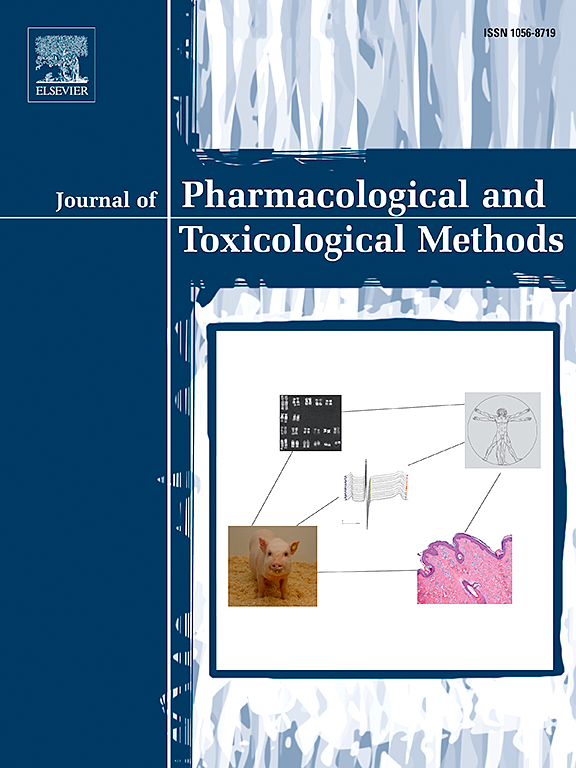生物碱/盐类(尼古丁、烟碱苯甲酸盐、咖啡因和氢溴酸槟榔碱)之间兴奋性差异的分子成像。
IF 1.3
4区 医学
Q4 PHARMACOLOGY & PHARMACY
Journal of pharmacological and toxicological methods
Pub Date : 2024-11-01
DOI:10.1016/j.vascn.2024.107569
引用次数: 0
摘要
比较四种不同生物碱/盐(包括尼古丁、烟碱苯甲酸盐、咖啡因和氢溴酸异山豆根碱)的兴奋性。基于正电子发射断层扫描(PET)成像和18F-法利肽,开发了一种测量SD大鼠生物碱/盐兴奋性的新技术。通过一次雾化吸入给 SD 大鼠注射不同剂量和类型的生物碱/盐。结果表明(1)PET成像技术可以无创实时检测SD大鼠单次吸入生物碱/盐类后的兴奋强度,且四种不同生物碱/盐类(尼古丁、苯甲酸烟碱、咖啡因和氢溴酸异丙嗪)的最佳PET扫描时间略有不同。(2)四种生物碱/盐类在 SD 大鼠体内单次吸入后观察到兴奋饱和效应,尼古丁、苯甲酸尼古丁、咖啡因和氢溴酸阿糖胞苷的饱和效应剂量分别为 0.063 mg/kg、0.075 mg/kg、0.33 mg/kg 和 0.075 mg/kg。(3)在单次吸入相同剂量的四种生物碱/盐的情况下,雄性 SD 大鼠吸入氢溴酸苔藓碱的兴奋性最强,而雌性 SD 大鼠吸入苯甲酸烟碱的兴奋性最强。建立了一种 PET 方法,用于无创实时检测 SD 大鼠体内生物碱/盐的兴奋性。发现四种生物碱/盐(烟碱、烟碱苯甲酸盐、咖啡因和氢溴酸异山豆根碱)的兴奋饱和效应,以及在相同剂量吸入四种生物碱/盐时存在兴奋强度和性别差异,为确定生物碱/盐的含量提供了新的理论依据。本文章由计算机程序翻译,如有差异,请以英文原文为准。
Molecular imaging of excitability difference between alkaloids/salts (nicotine, nicotinic benzoate, caffeine and arecoline hydrobromide)
Comparison of the excitability of four different alkaloids/salts, including nicotine, nicotinic benzoate, caffeine and arecoline hydrobromide. Based on positron emission tomography (PET) imaging and 18F-Fallypride, a novel technique for measuring alkaloid/salt excitability in SD rats was developed. Different doses and types of alkaloids/salts were administered to the SD rats in a single nebulised inhalation.
The results showed that: (1) PET imaging technology can detect the excitability intensity of SD rats after single inhalation of alkaloids/salts in non-invasive real time and the optimal PET scanning time of four different alkaloids/salts (nicotine, nicotinic benzoate, caffeine and arecoline hydrobromide) were slightly different. (2) The excitatory saturation effect of four alkaloids/salts was observed in SD rats after single inhalation and the saturation effect doses of nicotine, nicotine benzoate, caffeine and arecine hydrobromide were 0.063 mg/kg, 0.075 mg/kg, 0.33 mg/kg and 0.075 mg/kg, respectively. (3) In the case of single inhalation of the same dose of four alkaloids/salts, male SD rats inhaled arecoline hydrobromide with the strongest excitability, while female SD rats inhaled nicotinic benzoate. A PET method for noninvasive real-time detection of alkaloid/salt excitability in SD rats was established.
The finding of an excitatory saturation effect for four alkaloids/salts (nicotine, nicotinic benzoate, caffeine and arecoline hydrobromide) and the presence of excitatory intensity and gender differences at the same dose of inhalation of four alkaloids/salts, which provide a new theoretical basis for determiningthe content of alkaloids/salts.
求助全文
通过发布文献求助,成功后即可免费获取论文全文。
去求助
来源期刊

Journal of pharmacological and toxicological methods
PHARMACOLOGY & PHARMACY-TOXICOLOGY
CiteScore
3.60
自引率
10.50%
发文量
56
审稿时长
26 days
期刊介绍:
Journal of Pharmacological and Toxicological Methods publishes original articles on current methods of investigation used in pharmacology and toxicology. Pharmacology and toxicology are defined in the broadest sense, referring to actions of drugs and chemicals on all living systems. With its international editorial board and noted contributors, Journal of Pharmacological and Toxicological Methods is the leading journal devoted exclusively to experimental procedures used by pharmacologists and toxicologists.
 求助内容:
求助内容: 应助结果提醒方式:
应助结果提醒方式:


